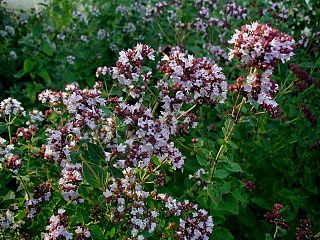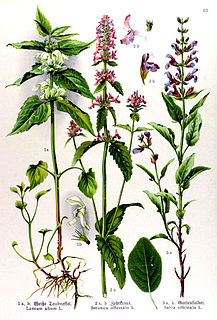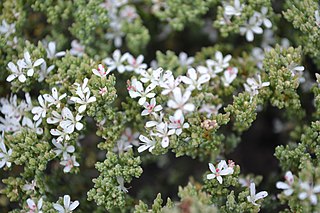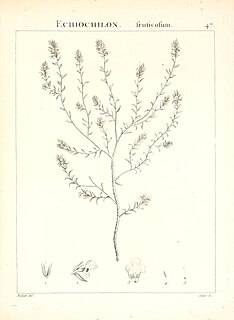
Nepeta is a genus of flowering plants in the family Lamiaceae. The genus name is reportedly in reference to Nepete, an ancient Etruscan city. There are about 250 species.

Satureja is a genus of aromatic plants of the family Lamiaceae, related to rosemary and thyme. It is native to North Africa, southern and southeastern Europe, the Middle East, and Central Asia. A few New World species were formerly included in Satureja, but they have all been moved to other genera. Several species are cultivated as culinary herbs called savory, and they have become established in the wild in a few places.

Marrubium is a genus of flowering plants in the family Lamiaceae, native to temperate regions of Europe, North Africa, and Asia as far east as the Xinjiang region of western China. A few species are also naturalized in North and South America.

Verbascum is a genus of over 450 species of flowering plants, common name mullein, in the figwort family Scrophulariaceae. They are native to Europe and Asia, with the highest species diversity in the Mediterranean.

Stachys is one of the largest genera in the flowering plant family Lamiaceae. Estimates of the number of species in the genus vary from about 300, to about 450. The type species for the genus is Stachys sylvatica. Stachys is in the subfamily Lamioideae. Generic limits and relationships in this subfamily are poorly known.

Ajuga, also known as bugleweed, ground pine, carpet bugle, or just bugle, is a genus of 40 species annual and perennial herbaceous flowering plants in the Ajugeae tribe of the mint family Lamiaceae, with most species native to Europe, Asia, and Africa, but also two species in southeastern Australia. They grow to 5–50 cm tall, with opposite leaves.

Tribulus is a genus of plants in the family Zygophyllaceae and found in diverse climates and soils worldwide from latitudes 35°S to 47°N. The best-known member is T. terrestris, a widespread invasive species and weed.

Origanum is a genus of herbaceous perennials and subshrubs in the family Lamiaceae, native to Europe, North Africa, and much of temperate Asia, where they are found in open or mountainous habitats. A few species also naturalized in scattered locations in North America and other regions.

Trigonella is a genus from the family Fabaceae. The best known member is the herb fenugreek. Members of the genus occur naturally in the Canary Islands, southern Europe, non‑tropical Africa, western and central Asia, the Indian subcontinent, and Australia.

Arenaria is a genus of flowering plants, within the family Caryophyllaceae.

Ballota (horehound) is a genus of flowering evergreen perennial plants and subshrubs in the family Lamiaceae. native to temperate regions. The Mediterranean region has the highest diversity in the genus, with more isolated locations in South Africa, Central Asia, northern Europe, and the islands of the eastern North Atlantic. It is found in rocky and waste ground.

Betonica is a genus of the plants in the family Lamiaceae.

Lagochilus is a genus of the mint family that contains Turkistan mint.

Micromeria is a genus of flowering plants in the mint family, Lamiaceae, widespread across Europe, Asia, Africa, and North America, with a center of diversity in the Mediterranean region and the Canary Islands. It is sometimes placed within the genus Satureja. The name is derived from the Greek words μῑκρος (mīkros), meaning "small," and μερίς (meris), meaning "portion," referring to the leaves and flowers.
- Micromeria acropolitanaHalácsy - Greece
- Micromeria albanica(K.Malý) Šilic - Albania, Yugoslavia
- Micromeria × angosturaeP.Pérez Gran Canaria in the Canary Islands (M. tenuis subsp. linkii × M. varia subsp. canariensis)
- Micromeria arganietorum(Emb.) R.Morales - Morocco
- Micromeria benthamiiWebb & Berthel. - Gran Canaria in the Canary Islands
- Micromeria × benthamineolensSvent. - Gran Canaria in the Canary Islands (M. benthamii × M. pineolens)
- Micromeria biflora(Buch.-Ham. ex D.Don) Benth. - Himalayas from Afghanistan to Myanmar
- Micromeria × bourlieriMaire & Le Lièvre - Algeria, Morocco (M. graeca × M. inodora)
- Micromeria brivesiiBatt. - Morocco
- Micromeria × broussonetiiA.Santos, A.Acev.-Rodr. & Reyes-Bet. - Canary Islands (M. densiflora × M. varia)
- Micromeria browicziiZiel. & Kit Tan - Greece
- Micromeria chionistraeMeikle - Cyprus
- Micromeria conferta(Coss. & Daveau) Stefani - Libya
- Micromeria × confusaG.Kunkel & P.Pérez - Gran Canaria in the Canary Islands (M. benthamii × M. lanata)
- Micromeria cremnophilaBoiss. & Heldr. - Albania, Greece, Turkey, Syria, Lebanon
- Micromeria cristata(Hampe) Griseb. - Albania, Greece, Yugoslavia, Turkey, Bulgaria, Iran, Cyprus
- Micromeria croatica(Pers.) Schott - Albania, Yugoslavia
- Micromeria cymuligeraBoiss. & Hausskn. - Turkey
- Micromeria danaensisDanin - Jordan
- Micromeria debilisPomel - Algeria, Morocco
- Micromeria densifloraBenth. - Tenerife in the Canary Islands
- Micromeria ellipticaK.Koch - Turkey
- Micromeria filiformis(Aiton) Benth. - Corsica, Sardinia, Balearic Islands
- Micromeria flacca(Nábelek) Hedge - Turkey, Iraq
- Micromeria flagellarisBaker - Madagascar
- Micromeria fontanesiiPomel - Algeria, Morocco
- Micromeria forbesiiBenth. - Cape Verde Islands
- Micromeria fruticosa(L.) Druce - Eastern Mediterranean
- Micromeria glomerataP.Pérez - Tenerife in the Canary Islands
- Micromeria graeca(L.) Benth. ex Rchb. - Mediterranean from Morocco + Portugal to Turkey
- Micromeria guichardii(Quézel & Zaffran) Brullo & Furnari - Libya
- Micromeria hedgeiRech.f. - Iran
- Micromeria helianthemifoliaWebb & Berthel. - Gran Canaria in the Canary Islands
- Micromeria herpyllomorphaWebb & Berthel. - La Palma in the Canary Islands
- Micromeria hispidaBoiss. & Heldr. ex Benth. - Crete
- Micromeria hochreutineri(Briq.) Maire - Algeria, Morocco
- Micromeria × hybridaZagan - Greece including Crete (M. graeca × M. nervosa)
- Micromeria hyssopifoliaWebb & Berthel. - Tenerife + El Hierro in the Canary Islands
- Micromeria imbricata (Forssk.)C.Chr. - Africa from Nigeria to Ethiopia to Transvaal, Arabian Peninsula
- Micromeria inodora(Desf.) Benth. - Algeria, Morocco, Tunisia, Spain including Balearic Islands
- Micromeria × intermediaG.Kunkel & P.Pérez - Gran Canaria in the Canary Islands (M. benthamii × M. helianthemifolia)
- Micromeria juliana(L.) Benth. ex Rchb. - Mediterranean
- Micromeria kerneriMurb. - Yugoslavia
- Micromeria lachnophyllaWebb & Berthel. - Tenerife in the Canary Islands
- Micromeria lanata(C.Sm. ex Link) Benth. - Gran Canaria in the Canary Islands
- Micromeria lasiophyllaWebb & Berthel. - Canary Islands
- Micromeria lepidaWebb & Berthel. La Gomera in the Canary Islands
- Micromeria leucanthaSvent. ex P.Pérez - Gran Canaria in the Canary Islands
- Micromeria longipedunculataBräuchler - Yugoslavia, Albania
- Micromeria macrosiphonCoss. - Morocco
- Micromeria madagascariensisBaker - Madagascar
- Micromeria marginata(Sm.) Chater - Alpes Maritimes in France, Liguria + Sardinia in Italy
- Micromeria × meteoricaHausskn. - Greece (M. cremnophila × M. juliana)
- Micromeria microphylla(d'Urv.) Benth. - Balearic Islands, Sicily, Malta, southern mainland Italy, Crete, Cyprus, Libya
- Micromeria monantha(Font Quer) R.Morales - Morocco
- Micromeria myrtifoliaBoiss. & Hohen. - from Greece to Iran
- Micromeria nervosa(Desf.) Benth. - Mediterranean from Algeria + Balearic Islands to Turkey
- Micromeria × nogalesiiG.Kunkel & P.Pérez - Gran Canaria in the Canary Islands
- Micromeria peltieri(Maire) R.Morales - Morocco
- Micromeria × perez-paziiG.Kunkel - Gran Canaria in the Canary Islands (M. benthamii × M. tenuis)
- Micromeria persicaBoiss. - Iran, Iraq, Turkey
- Micromeria pineolensSvent. - Gran Canaria in the Canary Islands
- Micromeria × preauxiiWebb & Berthel. - Gran Canaria in the Canary Islands (M. benthamii × M. varia subsp. canariensis)
- Micromeria pseudocroaticaŠilic - Yugoslavia
- Micromeria rivas-martineziiWildpret - Tenerife in the Canary Islands
- Micromeria serbalianaDanin & Hedge - Sinai
- Micromeria sinaicaBenth. - Sinai, Israel
- Micromeria sphacioticaBoiss. & Heldr. ex Benth.- Crete
- Micromeria sphaerophyllaBaker - Madagascar
- Micromeria suborbicularis(Alain) Borhidi - Cuba
- Micromeria × tagananensisP.Pérez - Tenerife in the Canary Islands (M. glomerata × M. varia)
- Micromeria teneriffae(Poir.) Benth. ex G.Don - Tenerife in the Canary Islands
- Micromeria tenuis(Link) Webb & Berthel. - Gran Canaria in the Canary Islands
- Micromeria unguentariaSchweinf. - Ethiopia
- Micromeria variaBenth. - Canary Islands, Madeira, Cape Verde Islands
- Micromeria weilleri(Maire) R.Morales - Morocco
- Micromeria × wildpretiiP.Pérez - Tenerife in the Canary Islands (M. rivas-martinezii × M. varia)

Nanorrhinum is a genus of flowering plant in family Plantaginaceae.

Frankenia is the only genus in the Frankeniaceae family of flowering plants. Other genera have been recognized within the family, such as Anthobryum, Hypericopsis and Niederleinia, but molecular phylogenetic studies have consistently shown that they all belong inside Frankenia. Frankenia comprises about 70–80 species of shrubs, subshrubs and herbaceous plants, adapted to saline and dry environments throughout temperate and subtropical regions. A few species are in cultivation as ornamental plants.

Eremogone is a genus of flowering plants in the family Caryophyllaceae, native to western North America, northern Asia, eastern Europe and northeastern Africa. Attempts to resolve taxonomic relationships within the Caryophyllaceae have resulted in the enlargement of Eremogone with species from other genera.

Echiochilon is a genus of flowering plants belonging to the family Boraginaceae.
Mesostemma is a genus of flowering plants belonging to the family Caryophyllaceae.


















